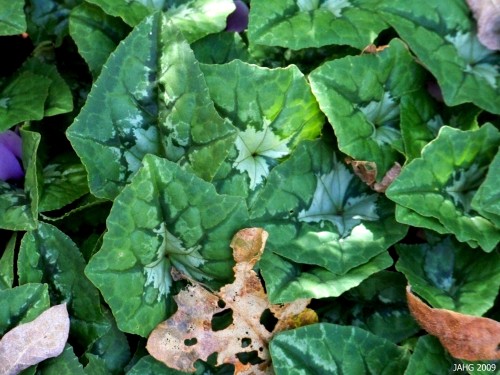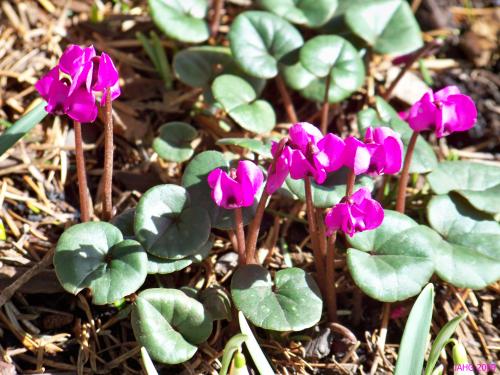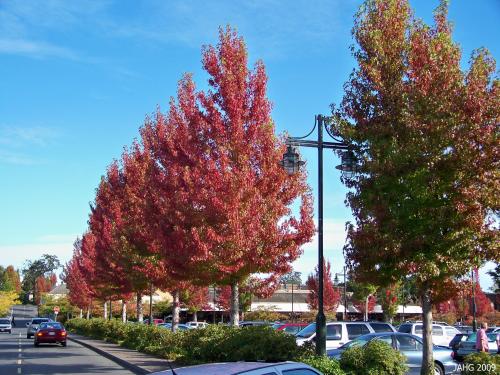When I came to live on the coast i was surprised to see how some plants were used. the climate here is just a notch below where many tender annuals will grow as perennials such as Snapdragons which winter over, sometimes for many years like the ones outside my kitchen window. Others are house plants elsewhere like Fatsia which grows as an attractive shade tolerant shrub here. One of the most surprising to me was the delicate and dainty Cyclamen which even as a house plant where a mystery to us. It was quite thrilling to find that Cyclamen hederifolium(Ivy-leaved Cyclamen)produce an especially abundant display here.

The delicate and dainty Cyclamen hederifolium blossom.
Cyclamen hederifolium was named in 1789 by Aiton but for many years has wrongly been sold as Cyclamen neapolitanum. More recently it has been split into varieties which refer to where it is found. C. hederifolium var. hederifolium and C. hederifolium var. confusum which we non-specialists can say are basically the same. we do know that these plants do grow in a wide area from southern France down into Italy and its islands. Then it moves east through Croatia, Bosnia down through Greece and it’s many islands over to western Turkey. It grows in a wide range of terrains from sea level up to 1400m(4300ft). It ranges from the richer soils of woodlands to maquis and gariques which have dry thin soils and occur on the dry lower mountainous slopes of the Mediterranean area.

The summer drought here does not bother Cyclamen hederifolium at all.
There are many places I have found these beauties. Playfair Park has the best and most bountiful display right now in amongst it’s Rhododendron collection. In Finnerty Gardens you will find them dotted about in shady spots. I also found them out along a country roadside where they have naturalized in clumps.Cyclamen is from the ancient greek ‘kylos’ meaning circle which refers to the shape of the corm it’s growth springs from. One Cyclamen hederifoliums’ common name is ‘Sowbread’ which refers to Cyclamen which is said to be the favorite food of swine in southern France and Italy. Ivy-leaved and ‘hederifolium’ refer to this Cyclamens the attractive leaves.

The interesting markings of Ivy-leaved Cyclamen are varied and colorful in the cool grey, drab winters here.
There are several species of Cyclamen which are seen regularly in gardens here. Cyclamen coum is the other most commonly grown variety. It is easily separated from Cyclamen hederifolium by it round, kidney shaped leaves and it bloom period which is in the early spring. Both are easy to grow and have long lasting, attractive foliage.

Cyclamen coum have rounded leaves and bloom in February and March.
Cyclamen hederifolium grow from a thick woody corm which is bulb-like. This corm helps the plant survive the long hot, dry summer season in the Mediterranean. It is easy to grow these beauties. They like to grow in fun sun to part shade in a location with soil which has at least a good part in leaf mold. Plant the tubers with their budding side up 3-5cm(1/2-1 1/2in) deep. Avoid planting in an area which has summer wet as this is the time of rest for this species. Water throughout fall into late spring as this is the growing season. These plants grow well under dappled shrubs and are also excellent container plants. In the wild pink is the most common color, while in cultivation whites are much more commonly seen.

Lush Cyclamen hederifolium plants are attractive in the dead of winter at Playfair Park.
Ivy-leaved Cyclamen spring from the earth and remind us that summer is waning. Autumn is about to come forth with all it’s brilliant shades and slowly the seasons change with longer nights to come.
More about Cyclamen hederifolium:
From the Cyclamen Society: http://www.cyclamen.org/hederif_set.html
How to grow Cyclamen: http://www.hardycyclamens.com/grow_hardy_cyclamen.html
Dave’s Garden always has interesting comments from other gardeners: http://davesgarden.com/guides/pf/go/1590/
Until we meet again….


















 Stumble It!
Stumble It!






